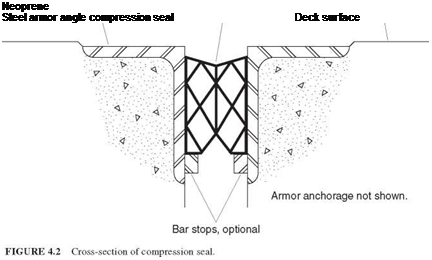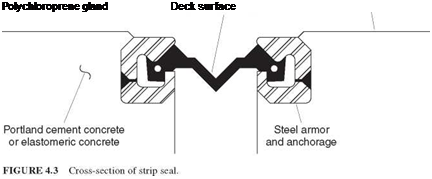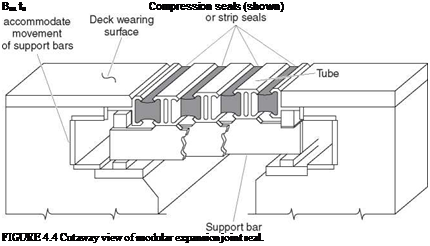Prestressed-Concrete Box-Beam Bridges
The span range of a shallow bridge may be extended beyond the limits of a slab bridge by using precast prestressed-concrete box beams as illustrated in Fig. 4.6. The beams are prefabricated off-site. They are rectangular and, except for very shallow beams [12 in (305 mm)], which may be solid, have from one to three rectangular or circular voids. The void forms are either waterproofed cardboard or solid polystyrene foam and are left in the beams. Void drains must be provided to prevent entrapment of water. Prestressing strands are located on the bottom and in the sidewalls of the box, and may include debonded or deflected strands. The selection depends upon owner preference or, where the designer and owner allow the option, fabricator preference.
Wearing surface
This type of bridge can be constructed using adjacent beams or spread beams. In adjacent box-beam construction, prefabricated box beams are placed side by side, abutting each other. The box beams are connected by transverse tie rods or posttensioned tendons, or by welded connection of tie plates to plates embedded in the tops of the beams. Shear keys between beams are grouted. The combination of transverse connection and grouted shear keys is intended to make the beams act together as a unit and prevent relative movement and cracking at the longitudinal joints. This type of bridge can be erected quickly, and temporary traffic can be maintained on partially completed portions of the bridge. These features have made this a popular type of bridge, despite at least one shortcoming discussed below, and sometimes cause it to be selected over a competitive type when both types are viable candidates for a bridge of a given span length.
For low-traffic-count roads, the tops of the beams may constitute the riding surface, but on most bridges a topping will be used. This may be a composite concrete slab, which adds to the strength of the bridge, or an asphalt concrete overlay, which is used to smooth out any irregularities between beams, to compensate for difference between roadway profile and final camber of the beams, and sometimes to maintain continuity of pavement type when the adjacent roadway is asphalt concrete. A waterproofing membrane should be used with this type of construction, with special attention to the joints.
The elimination of movement at the longitudinal joints and the maintenance of a waterproof condition has not always been achieved, even when a composite concrete slab has been used. Leakage of roadway drainage containing deicing salt through longitudinal joints has sometimes resulted in corrosion of the prestressing strands. In some cases, wires have broken.
In spread-box construction, the beams are spaced apart, and a reinforced-concrete slab is constructed on top. The slab between the beams is formed, and stay-in-place steel forms are frequently used. This has been an economical type of construction in Pennsylvania. In bridges with end spans shorter than interior spans, the beams can be the same depth for aesthetic reasons, with the spacing between beams varied to meet structural requirements. However, diagonal and vertical cracks have been observed in the sidewalls of spread-box beams near supports in sharply skewed bridges. The fine diagonal cracks were most evident on the acute sides of the box beams.








